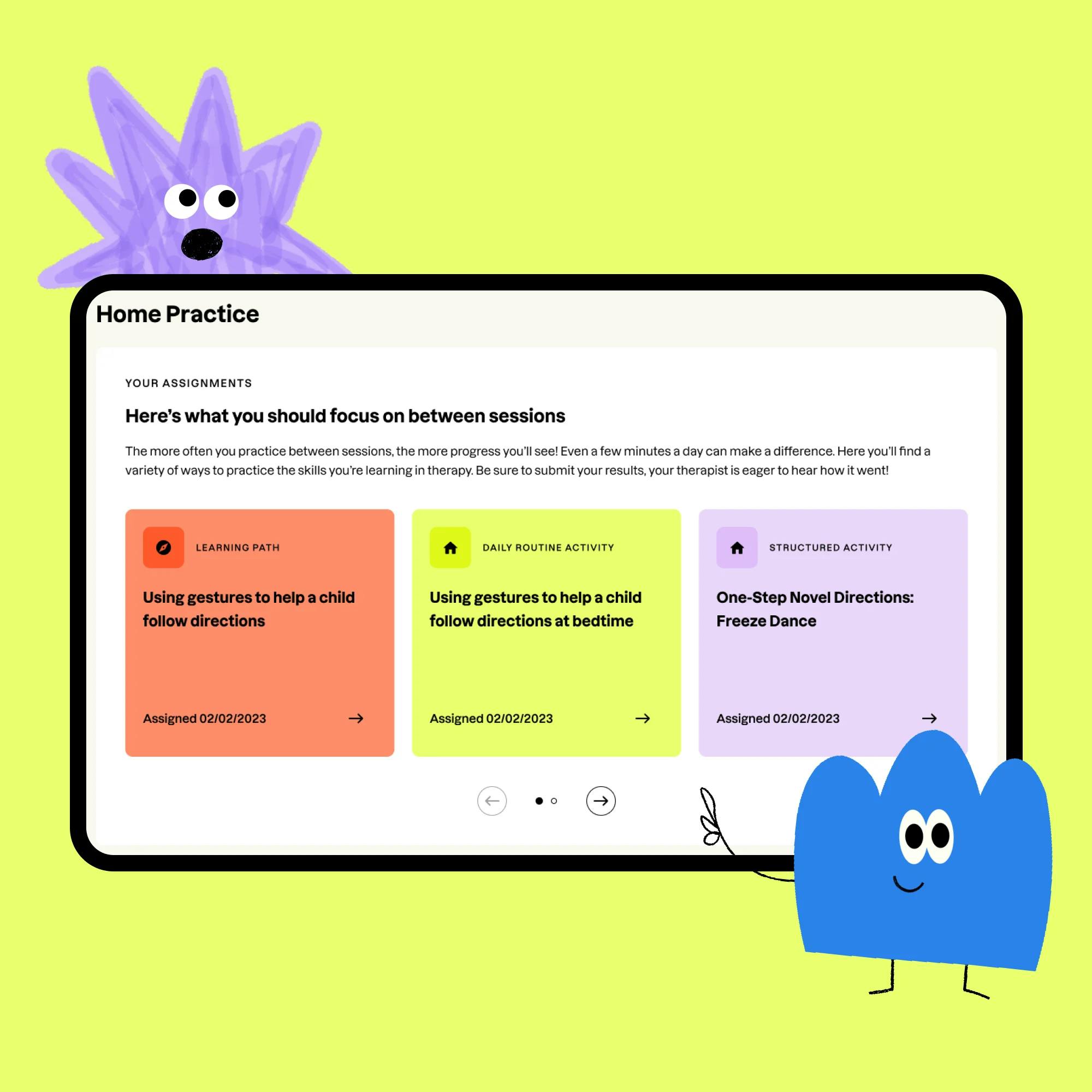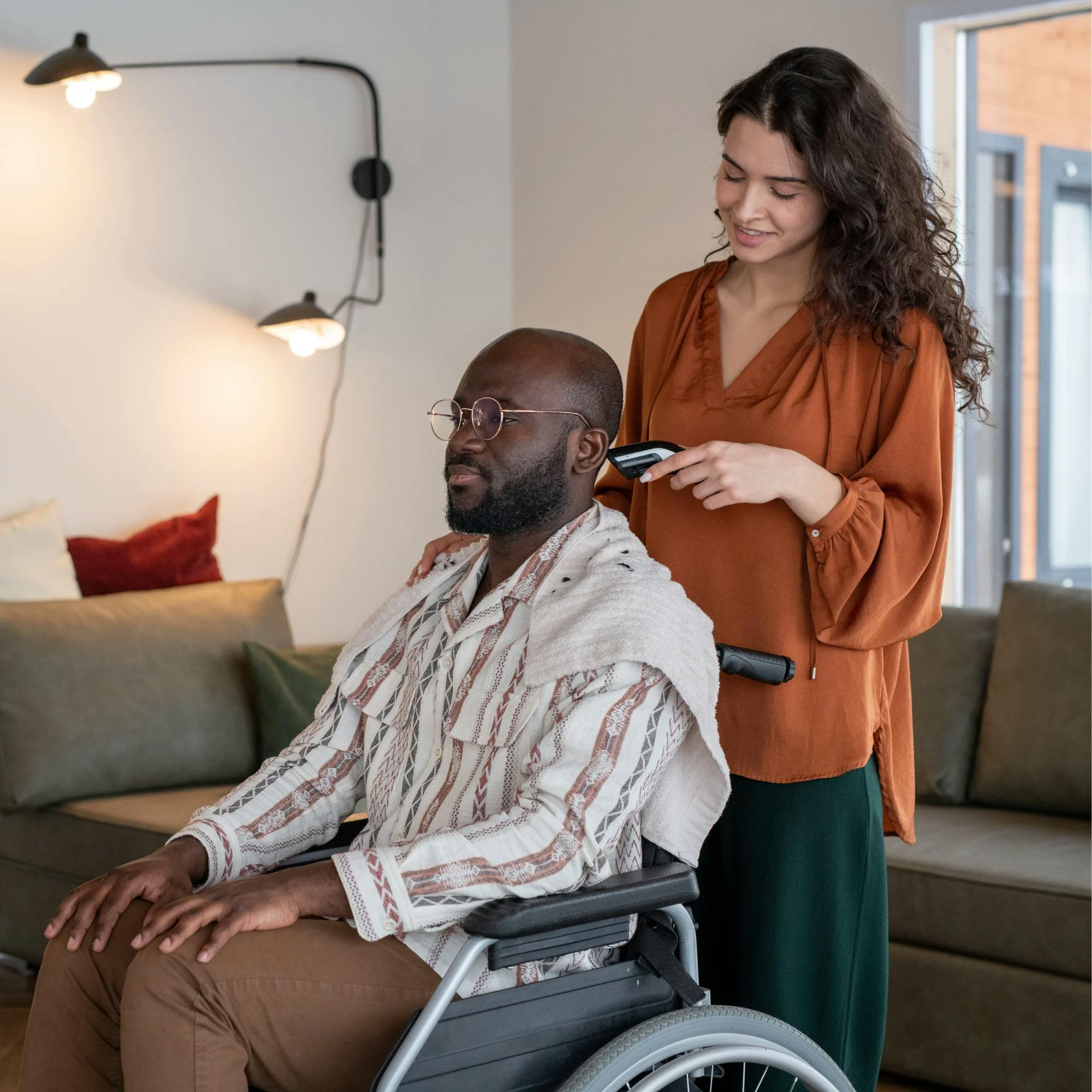
The Expert Guide to Acquired Apraxia of Speech: Causes, Symptoms, and Treatment
 Alexis Irazoque, M.S., CCC-SLP
Alexis Irazoque, M.S., CCC-SLP
At Expressable, we often hear from adults and families asking whether apraxia of speech can be treated and what type of progress to expect. Whether you're navigating a new diagnosis or noticing sudden changes in how a loved one speaks, it’s normal to have questions.
Apraxia of speech, also called verbal apraxia or AOS, is a motor speech disorder. It can make talking unexpectedly difficult, even though a person knows exactly what they want to say. Many people wonder, Can speech apraxia be cured? How is it diagnosed? What does treatment for apraxia look like?
This guide was created to answer those questions and more. Whether you're a caregiver, loved one, or someone living with apraxia, we’re here to help you understand what this condition sounds like, what causes it, and most importantly, how to treat it.
Expert speech support for adults
If you'd like to improve your speech skills, we're here for you. Get matched with a licensed speech therapist today.
 Get started
Get startedWhat is apraxia of speech?
In normal speech, the brain sends signals to the muscles in a person’s mouth (the lips, jaw, and tongue) in order to make accurate sounds and speak with normal speed and rhythm.
Apraxia is a neurological condition that disrupts this process. The person often has the language capacity to talk, but the signals between the brain and muscles are not sent correctly.
In other words, the brain knows what it wants to say, but it cannot properly plan the required movements for speech.
As a result, people with apraxia have difficulty coordinating the mouth movements needed to turn sounds into syllables, syllables into words, and words into phrases. It’s often hard for people with apraxia to communicate and form coherent sounds and sentences. Most commonly, people with apraxia are described as “difficult to understand."
There are different types of apraxia. This guide is focused on acquired apraxia of speech, which happens when a person who was able to speak loses that ability after a brain injury or illness. This form of apraxia is most often seen in adults.
What’s the difference between apraxia, dysarthria, and aphasia?
Apraxia of speech can be hard to recognize and understand because it’s often confused with other speech or language problems. To really understand what verbal apraxia is, it’s just as important to know what it is not.
Apraxia vs. dysarthria
While both apraxia and dysarthria are motor speech disorders, they are not the same. Dysarthria happens when the muscles used for speech (such as the tongue and lips) are weak or hard to control. This can make a person’s speech sound slurred, slow, or strained.
Apraxia is not caused by weak muscles. The problem comes from the brain having trouble planning the movements needed for speech. People with apraxia often know what they want to say, but their brain struggles to send the correct signals to their mouth.
In apraxia, the way someone says a word can change each time they try. In dysarthria, the speech errors tend to sound more consistent.
Apraxia vs. aphasia
Aphasia is a language disorder. It affects a person’s ability to use and understand words, including speaking, listening, reading, and writing. Aphasia is often caused by a stroke or brain injury.
While aphasia can affect how someone speaks, the problem is with language, not motor planning. People with apraxia may understand language just fine, but they have trouble getting their words out clearly. Sometimes, a person may have both apraxia and aphasia, which can make diagnosis more complicated.

What causes acquired apraxia of speech?
Acquired apraxia of speech happens when a person who was already able to speak loses that ability after a brain injury or illness. The apraxia is caused by damage to the parts of the brain that plan and coordinate speech movements. Common causes of acquired apraxia of speech include:
Brain tumors
Surgical trauma (for example, after a tumor is removed)
Progressive neurological diseases such as Alzheimer’s disease, Parkinson’s disease, or dementia
In some cases, verbal apraxia is the first or most noticeable symptom of a progressive condition like corticobasal degeneration or progressive supranuclear palsy. When this happens, it’s called primary progressive apraxia of speech. In these cases, the person’s speech may get worse over time as the disease progresses.


What does apraxia sound like?
The signs of verbal apraxia can vary from person to person.
Some people with apraxia only have trouble saying certain sounds or longer words. Others struggle to speak clearly at all. Symptoms of apraxia can also change over time. In some cases, speech improves. In others, especially if the cause is a progressive condition, speech may stay the same or become harder to understand.
Even though it looks different from person to person, there are some common signs of apraxia of speech. Signs of apraxia include:
Inconsistent speech errors: A person with apraxia might say the same word in different ways. For example, they may pronounce a word correctly one moment but struggle with it the next. This inconsistency is one of the key signs of apraxia.
Sound distortions and substitutions: Because the brain has trouble planning the movements needed for speech, sounds can come out distorted or replaced with the wrong ones. Vowel sounds and longer, more complex words are often the hardest.
Groping for words or sounds: People with apraxia may look like they’re searching for the right way to move their mouth. They may try to say a word several times before it comes out the way they want.
Struggles with rhythm and stress: Speech may sound choppy or robotic. People with apraxia often pause in odd places, stretch out sounds, or put equal stress on every syllable. For example, instead of the natural flow of “banana,” it might sound more like “ba-NA-na” or “BA-na-NA.”
Slowed speech rate and syllable separation: Speech may be slower overall, and syllables in words can sound spaced out or broken up, especially in longer or harder words. This happens because of difficulty planning how each part of a word connects smoothly.
How is apraxia of speech diagnosed?
Apraxia is a complex speech disorder that can be challenging to diagnose. Because apraxia can look like other speech and language problems, it’s important to be evaluated by a speech-language pathologist, also known as a speech therapist. The earlier you get help, the better. With the right therapy and support, many people with apraxia can make strong progress in their communication skills.
A speech therapist is the most qualified professional to diagnose and treat acquired apraxia of speech. The first step in this process is a comprehensive evaluation.
There’s no single test or symptom that confirms apraxia. Instead, speech therapists look for a pattern of signs and rule out other conditions that may look similar, like aphasia or dysarthria. This helps ensure that you get the right diagnosis and that your treatment is customized to your needs.
During your evaluation for apraxia, your speech therapist will look at several key areas, including:
Your speech and language skills
Your medical history
Your self-reported concerns, such as trouble talking at work or in social situations
They will also assess how your muscles move during speech (oral-motor skills) and how your brain plans and coordinates those movements. This is called motor speech planning.


To get the full picture, the evaluation often includes both standardized tests and informal assessments. These help your therapist understand:
Intelligibility: How easy it is for someone to understand your speech sounds
Comprehensibility: How well your message is understood when taking into account not just your speech, but also body language, gestures, and context
Efficiency: How quickly and clearly you're able to get your message across
These areas are important for setting realistic therapy goals that matter in your everyday life.
Your speech therapist may also analyze:
Your breathing, voice, and resonance during speech
Your non-speech oral movements, like how your tongue and lips move without speaking
Your language skills, to check for any overlapping difficulties
All of this information works together to help your speech therapist make a clear diagnosis and build a treatment plan that’s right for you.
What does apraxia treatment look like?
Treatment for apraxia of speech often involves frequent, one-on-one speech therapy sessions. These sessions are usually intensive and repetitive, with a focus on building the brain’s ability to plan and control the movements needed for speech. Your speech therapist will create a personalized treatment plan based on your unique needs, strengths, and speech abilities.
For many people with acquired apraxia of speech, treatment includes:
Practicing sounds, words, and phrases over and over
Watching how speech sounds are made (for example, by looking at the therapist’s mouth)
Saying words together with the speech therapist or a loved one
The main goal of treatment is to help the person communicate as clearly and independently as possible in daily life. This means not only working on speech sounds, but also building confidence, learning strategies, and removing barriers that make communication harder.
Some people with verbal apraxia may experience spontaneous recovery, where their speech improves on its own over time. However, many people benefit from speech therapy to strengthen their communication skills, especially for more severe cases.
Every person’s journey is different. Progress may be fast for some and slower for others. What’s most important is consistency, encouragement, and practice outside of therapy, especially with help from family and friends.
Get matched with a speech therapist who's right for you
Get started nowWhat if speech is still hard?
In more severe cases, adults with apraxia may need other ways to express themselves while working on their speech. These are called augmentative and alternative communication (AAC) methods. They may include:
Gestures or sign language
Pointing to words or pictures in a notebook
Using an AAC device, like a tablet that can type or speak words out loud
These tools are not meant to replace speech forever. Instead, they support communication while the person continues to build their speech skills. Using AAC can reduce frustration, boost confidence, and help the person take part in everyday life.
How does Expressable evaluate and treat apraxia of speech?
At Expressable, we match adults with a licensed speech-language pathologist trained to evaluate and treat acquired apraxia of speech. All therapy is provided online through live, face-to-face video sessions, making it easy to access from home.
Many adults attend their sessions on their own, but caregivers or family members are always welcome to join and learn how to support their loved one at home.
At Expressable, our apraxia of speech program is created by clinical experts, grounded in the latest research, and designed specifically for adults. Your therapist will start by evaluating your speech using a combination of tools, as described above. These may include:
Standardized or informal tests
Checklists and screeners
Observations of how clearly you're understood
Input from you and your loved ones
This information helps build a personalized care plan tailored to your speech abilities and communication goals. We typically recommend two sessions per week, but this may vary depending on your needs.
Why apraxia treatment matters
Speech therapy is important for verbal apraxia because it helps:
Improve your speech clarity and confidence
Support daily communication at home, work, and in the community
Boost your overall quality of life through better social interaction and independence
Empower you to express your thoughts, feelings, and needs
Speech therapy for apraxia may include a mix of restorative exercises (to improve how speech is produced) and compensatory strategies (to support communication in daily life).
Support beyond sessions: The Expressable portal
Learning doesn't stop when your session ends. At Expressable, you’ll get access to a secure client portal that helps you practice and reinforce skills at home. Here’s what you’ll find:
Learning Paths that explain key strategies for apraxia, like using verbal or visual cues, or changing your environment to support speech.
Demo videos that show real techniques in action, like how to correctly move your mouth to make sounds.
Home practice activities to work on speech during your everyday routines. For example: practicing cloze phrase treatment while making appointments or ordering food.
Text messaging with your therapist for tips, reminders, and answers to questions between sessions.
When you practice regularly and apply what you’re learning in real life, you make faster progress and build more independence.


Tips for family and caregivers: How to help your loved one with apraxia
If someone you care about has acquired apraxia of speech, your support can make a big difference. Communication can be hard work for them, but there are many ways you can make it easier and more comfortable.
Here are 10 helpful tips for family members, caregivers, and friends:
1 Be face-to-face
Always try to speak while facing your loved one. Seeing your mouth, face, and hand gestures can make it easier for them to understand and respond.
2 Keep it calm and simple
Use short, clear sentences. Speak slowly and gently. Staying calm can help your loved one feel more relaxed and confident.
3 Minimize distractions
Turn off the TV or reduce background noise during conversations. A quiet space makes it easier to focus and communicate clearly.
4 Be patient
Give your loved one time to speak. Don’t finish their sentences, even if you think you know what they’re going to say. Letting them try builds confidence and supports progress.


5 Break things down
If you’re giving instructions, break them into smaller steps. After each step, pause and make sure it’s understood before moving on.
6 Show, don’t just tell
If something is hard to explain with words, try showing it with a gesture or action. Demonstrating can help make your message clearer.
7 Encourage other ways to communicate
If speech is difficult, support your loved one in using gestures, pointing, writing, or drawing. You might ask, “Can you show me what you mean?” or offer them a pen and paper.
8 Ask simple questions
Try not to ask open-ended questions like “What do you want to do today?” Instead, offer choices, like “Do you want to go to the park or the store?” Even yes/no questions like “Do you want to go to the park?” can be very helpful, especially when your loved one is tired.
9 Watch for frustration and fatigue
Speaking can be exhausting. If your loved one seems frustrated or tired, take a break and try again later. A short rest can help the brain reset.
10 Offer help, but don’t jump in too soon
It’s okay to help, but try not to take over. Let your loved one stay in control of their communication. If they’re struggling, gently ask, “Do you want help?” or say, “Let me know if you need help.”
Remember to take care of yourself, too. Supporting someone with a communication disorder can be challenging. Be patient with yourself. You’re doing your best, and your support means everything.
Get started with Expressable
Speech therapy helps people with verbal apraxia of speech express themselves and connect with others. Find the right speech therapist for the support you or your loved one needs. Start our simple sign-up here!
How Expressable Can Help
Concerned your child isn't reaching age-expected milestones? Looking for communication support from a professional? Expressable is a national online speech therapy practice serving children and adults. We treat all major areas of communication and feeding, offer flexible hours including evenings and weekends, and accept most major health insurance plans. We’re proud to have earned more than 3,000 5-star reviews from our clients (4.9/5 average).
Our therapy model is centered on parent and caregiver involvement. Research proves that empowering caregivers to participate in their loved one’s therapy leads to better outcomes. That’s why we combine live, 1-on-1 speech therapy with personalized education and home practice activities for faster progress.
Communication is more than words. It’s how we share how we feel and show who we are. We’re here to help you or your child do just that.








